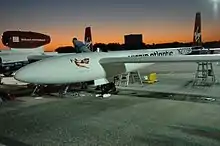Fuel fraction
In aerospace engineering, an aircraft's fuel fraction, fuel weight fraction,[1] or a spacecraft's propellant fraction, is the weight of the fuel or propellant divided by the gross take-off weight of the craft (including propellant):[2]

The fractional result of this mathematical division is often expressed as a percent. For aircraft with external drop tanks, the term internal fuel fraction is used to exclude the weight of external tanks and fuel.
Fuel fraction is a key parameter in determining an aircraft's range, the distance it can fly without refueling. Breguet’s aircraft range equation describes the relationship of range with airspeed, lift-to-drag ratio, specific fuel consumption, and the part of the total fuel fraction available for cruise, also known as the cruise fuel fraction, or cruise fuel weight fraction.[3]
Fighter aircraft
At today’s state of the art for jet fighter aircraft, fuel fractions of 29 percent and below typically yield subcruisers; 33 percent provides a quasi–supercruiser; and 35 percent and above are needed for useful supercruising missions. The U.S. F-22 Raptor’s fuel fraction is 29 percent,[4] Eurofighter is 31 percent, both similar to those of the subcruising F-4 Phantom II, F-15 Eagle and the Russian Mikoyan MiG-29 "Fulcrum". The Russian supersonic interceptor, the Mikoyan MiG-31 "Foxhound", has a fuel fraction of over 45 percent.[5] The Panavia Tornado had a relatively low internal fuel fraction of 26 percent, and frequently carried drop tanks.[6]
Airliners
Airliners have a fuel fraction of less than half their takeoff weight, between 26% for medium-haul to 45% for long-haul:
| Model | MTOW (t) | OEW (t) | OEW Fraction | Fuel capacity (t) | Fuel fraction | Payload Max. (t) | Payload fraction |
|---|---|---|---|---|---|---|---|
| Airbus A380[7] | 575 | 285 | 49.6% | 254 | 44.2% | 84 | 14.6% |
| Boeing 777-300ER[8] | 351.5 | 167.8 | 47.7% | 145.5 | 41.4% | 69.9 | 19.9% |
| Boeing 777-200LR[8] | 347.5 | 145.2 | 41.8% | 145.5 | 41.9% | 64.0 | 18.4% |
| Airbus A350-1000[9] | 308 | 156 | 50.6% | 122.5 | 39.8% | 64 | 20.8% |
| Airbus A350-900[9] | 280 | 142.7 | 51% | 108.3 | 38.7% | 53 | 18.9% |
| Boeing 787-9[10] | 254 | 128.9 | 50.7% | 101.5 | 40% | 52.6 | 20.7% |
| Airbus A330-300[11] | 242 | 130 | 53.7% | 109.2 | 45.1% | 45 | 18.6% |
| Airbus A330-200[11] | 242 | 121 | 50% | 109.2 | 45.1% | 49 | 20.2% |
| Boeing 787-8[10] | 227.9 | 120 | 52.7% | 101.3 | 44.4% | 43.3 | 19% |
| Airbus A320ceo[12] | 79 | 44.3 | 56.1% | 23.3 | 29.5% | 20 | 25.3% |
| Boeing 737-800[13] | 79 | 41.4 | 52.4% | 20.9 | 26.5% | 21.3 | 27% |
| Bombardier CS300[14] | 67.6 | 37.1 | 54.9% | 17.2 | 25.5% | 18.7 | 27.7% |
| Bombardier CS100[14] | 60.8 | 35.2 | 57.9% | 17.6 | 29% | 15.1 | 24.9% |
The Concorde supersonic transport had a fuel fraction of 51%.
General aviation
The Rutan Voyager took off on its 1986 around-the-world flight at 72 percent, the highest figure ever at the time.[15] Steve Fossett's Virgin Atlantic GlobalFlyer could attain a fuel fraction of nearly 85 percent, meaning that it carried more than five times its empty weight in fuel.[16]
See also
References
- Brandt, Steven (2004). Introduction to Aeronautics: a Design Perspective. AIAA (American Institute of Aeronautics & Ast). p. 359. ISBN 1-56347-701-7.
- Vinh, Nguyen (1993). Flight Mechanics of High-Performance Aircraft. Cambridge: Cambridge University Press. p. 139. ISBN 0-521-47852-9.
- Filippone, Antonio (2006). Flight Performance of Fixed and Rotary Wing Aircraft. Elsevier. p. 426. ISBN 0-7506-6817-2.
- 8200/27900 = 0.29
- The F-22 Program FACT VERSUS FICTION Archived 2007-04-21 at the Wayback Machine by Everest E. Riccioni, Col. USAF, Ret.
- Spick, Mike (2002). Brassey's Modern Fighters. Washington: Potomac Books. pp. 51–53. ISBN 1-57488-462-X.
- "A380 Aircraft Characteristics – Airport and Maintenance Planning" (PDF). Airbus. December 2016.
- 777-200LR/-300ER/-Freighter Airplane Characteristics for Airport Planning (PDF) (Technical report). Boeing. May 2015.
- "A350 Aircraft Characteristics – Airport and Maintenance Planning" (PDF). Airbus. November 2016. Archived from the original (PDF) on 2016-11-28.
- "787 Airplane Characteristics for Airport Planning" (PDF). Boeing. December 2015.
- "A330 Aircraft Characteristics – Airport and Maintenance Planning" (PDF). Airbus. December 2016.
- "A320 Aircraft Characteristics – Airport and Maintenance Planning" (PDF). Airbus. June 2016.
- "737 Airplane Characteristics for Airport Planning" (PDF). Boeing. September 2013.
- "CSeries brochure" (PDF). Bombardier. June 2015. Archived from the original (PDF) on 2015-09-08. Retrieved 2017-10-22.
- Noland, David (February 2005). "Burt Rutan and the Ultimate Solo". Popular Mechanics. Archived from the original on 2006-12-11.
-
Schneider, Mike (2006-02-06). "Adventurer Set for Record-Setting Flight". Space.com. Associated Press. Retrieved 2007-03-18.
At takeoff, fuel is expected to account for almost 85 percent of the graphite-made aircraft's weight.